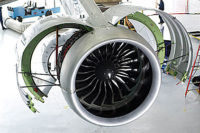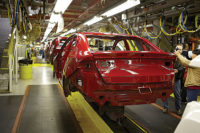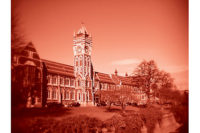"Watch where you step so you avoid the poisonous snakes!” is not something that’s typically heard when touring an automotive assembly plant. But, Volkswagen
| Jump to: |
AG’s two-year-old Chattanooga, TN, facility is out of the ordinary when it comes to being environmentally friendly.
The state-of-the-art factory is the newest and greenest plant in the North American auto industry. Besides being home to the Passat sedan, the vast grounds of VW Chattanooga are home to a wide variety of wildlife, including beavers, birds, deer, frogs, rabbits, turkeys and turtles. There are also copperhead snakes lurking about in the grassy fields surrounding the plant’s huge solar farm.
Being a friend of nature is all part of VW’s “Think Blue. Factory” initiative. Volkswagen is aiming to make its automobile production footprint more environmentally compatible by the end of this decade. Energy and water consumption, wastewater production, and solvent and carbon dioxide emissions are to be reduced by 25 percent corporate-wide by 2018.
“Volkswagen’s worldwide commitment to environmental protection [is] a broadly focused initiative for all [our] plants to achieve more efficient use of energy, materials and water, and produce less waste and emissions,” says Frank Fischer, CEO and chairman of Volkswagen Group of America Chattanooga Operations LLC.
The $1 billion Tennessee plant is leading the green charge and serving as a corporate-wide benchmark for sustainable manufacturing. In fact, the facility is being used as a blueprint for several new VW plants under construction in China.
The innovative factory is located 11 miles east of downtown Chattanooga, just off I-75, a busy north-south artery in the Southeast. The short drive into the plant from the highway is remarkably unassuming. After following a meandering road lined with oak trees, the sprawling complex suddenly appears in the valley below. Executives from Volkswagen’s corporate headquarters in Wolfsburg, Germany, refer to the bucolic setting as “the factory in the woods.”
Indeed, the plant is designed to peacefully coexist with nature. Two streams flow through the 1,350-acre complex, which is surrounded by open fields, ponds, rolling hills and natural grass.
The 2-million-square foot facility consists of three main buildings: an assembly plant, a body shop and a paint shop. In addition, there’s a supplier park and a Volkswagen Academy for training assemblers.
Ambitious Goal
Volkswagen’s long-term goal is to be the No. 1 automaker in the world by 2018—surpassing General Motors and Toyota. By the end of this decade, VW plans to build 10 million vehicles worldwide, with the United States accounting for 8 percent of that volume. With an annual capacity of 180,000 cars, the Chattanooga plant is expected to play a key role in that ambitious strategy.
In fact, the facility recently assembled its 250,000th Passat sedan, and it is planning to produce a sport-utility vehicle in the near future. In addition, a parcel of land adjacent to the existing factory has already been graded and prepared to accommodate a duplicate plant some day.
The Chattanooga project marks VW’s second production foray into the United States. In the late 1970s, it started assembling Rabbit subcompacts at a former Chrysler factory in New Stanton, PA. A decade later, with the facility operating at less than 40 percent capacity, VW shut it down and shipped the production equipment to China.
When Volkswagen decided to re-establish a manufacturing presence in the United States five years ago, it started from scratch and vowed to become an environmental steward. The automaker built a state-of-the-art operation on the site of the former Volunteer Army Ammunition Plant.
The 6,000-acre complex produced explosives during World War II, the Korean War and the Vietnam War. During peak operations in the late 1960s, more than 400 buildings and bunkers on the site produced 30 million pounds of TNT per month. Production ceased in 1977 and remediation efforts began.
Today, a few of the original buildings still exist, but a large chunk of the brownfield site has been converted into a 2,800-acre nature park that offers miles of wooded bike trails, walking paths and picnic areas.
Volkswagen contracted with SSOE Group, an engineering, procurement and construction management firm based in Toledo, OH, that has worked with other automakers, such as BMW, Ford, GM and Toyota. The company’s architects and engineers created a green showcase in Chattanooga that has received many honors, including the Edison Green Award and the Grand Award for Engineering Excellence from the American Council of Engineering Companies.
The facility is also the first and only LEED (Leadership in Energy and Environmental Design) Platinum automotive manufacturing plant in the world and the first LEED Platinum industrial campus in the United States. The Platinum certification is the highest designation possible from the U.S. Green Building Council.
In addition, VW Chattanooga is certified according to ISO 14001 for its environmental management system and ISO 50001 for its energy management system.
Blue Meets Green
Volkswagen’s famous logo may be blue, but its Chattanooga plant bleeds green. “The factory is an important cornerstone in [our] ‘Think Blue. Factory’ initiative,” claims Jan Spies, head of factory planning at Volkswagen. “Throughout the project, [we] utilized many innovative methods to reduce environmental impact which ultimately supported the LEED Platinum certification.
Volkswagen’s famous logo may be blue, but its Chattanooga plant bleeds green. |
“This building saves 42 percent of energy consumed from both the manufacturing process and building facilities,” notes Spies. “The facility also uses rain water to reduce water usage by [several million gallons] per year.”
All buildings sport a white roof with a high albedoto minimize the heat island effect. The reflective roofing material lowers cooling costs and saves energy. In addition, roller-compacted concrete was used in lieu of asphalt in many areas of the parking lots and roads to reduce heat buildup.
“Air-handling equipment [uses] heat recovery wheels, which allow the reuse of heat energy prior to releasing it to the atmosphere,” adds Spies. “Extensive use of skylights ensure natural lighting throughout [the plant], which reduces the energy demand from light fixtures.”
The buildings feature thick walls with 6 inches of mineral rock wool insulation. “The insulated metal panels keep the plant cooler in the summer and warmer in the winter, while saving 720 megawatt hours per year,” says Ron Drumeller, environmental specialist for plant infrastructure at VW Chattanooga.
“This is also the first Volkswagen facility to rely entirely on LED systems for outdoor lighting, which uses 68 percent less energy than its predecessors,” Drumeller points out. “All exterior lights at the facility provide only the minimum lighting required for safety to ensure that light does not spill into the night sky, adversely affecting the surrounding nocturnal environments through excessive glare.”
Indoors, the production buildings and offices are equipped with energy-saving lamps controlled by motion sensors. “The entire lighting system uses 20 percent less energy than a comparable facility,” claims Drumeller.
When the plant was being built, 4,602 tons (78 percent) of construction and demolition waste was salvaged or recycled. And, 48 percent of total building materials were manufactured using recycled materials. For instance, more than 60,000 1-liter plastic bottles were recycled and reused in flooring.
The plant was built without disturbing any natural surroundings. In fact, two small streams were rerouted and restored to enhance wildlife habitat in the area and provide a wildlife corridor around the factory. Natural ground cover, such as buffalo grass and switch grass, was planted to save on irrigation.
“A 40-acre wetlands is home to seven threatened animal species,” says Kaye Fiorello, an environmental specialist at VW Chattanooga. “We even hold a bird count four times per year and we’ve determined that more than 60 different types of birds live in the area.” Earlier this year, Fiorello worked with a local school on a birdhouse-building project.
An 850-foot-long pedestrian bridge serves as the gateway to the plant, linking the main entrance and training center to the assembly line. The bridge crosses a stream and negotiates a big change in elevation between the parking lot and the plant.
One of the highlights of VW Chattanooga is its 33-acre solar farm. It features 33,600 polycrystalline panels that supply 13 percent of the plant’s power needs.
“Unlike some companies that install solar facilities in order to sell electricity back to utilities, we consume 100 percent of the electricity generated from the solar modules,” claims Dave Gustashaw, energy and utility specialist. “Ten inverters convert the solar energy from DC to AC to power electrical installations in the plant.”
Sustainable Production
The green theme outside the plant carries over onto the production floor. Sustainable technology is especially prevalent in the body and paint shops, which historically are the two most energy intensive parts of an automotive manufacturing facility.
The roof of the factory is slightly sloped so that rain water trickles into five drains and flows down into a concrete catch basin. Rain water is cooled by fans in the roof and stored for reuse in the body shop, which boasts more than 400 welding robots.
“The water is circulated and used to cool the copper electrode tips of our welding robots,” says Tim Hill, process coordinator. “This saves 290,000 gallons of water per year.”
Rain water is also harvested for use in the plantwide sanitary waste system. “Through low-flow water closets and urinals, the plant achieves a 58 percent reduction in potable water used for sewage conveyance,” says Drumeller. “Together, these strategies save 1.7 million gallons of potable water each year. Low-flow showers in the fitness center, plus lavatory and kitchen faucets, further decrease potable water usage, resulting in total savings of more than 3 million gallons of potable water annually.”
The VW Chattanooga paint shop consumes 20 percent less energy than the typical facility. It has one less spray booth and dryer than is typically found in an auto plant, because there’s no primer coat of paint used. The shop uses a painting process without any filler, which reduces CO2 emissions.
Volkswagen built the first automobile paint shop to use a waterless separation process for topcoat application. The paint shop uses a dry-scrubber system to collect paint overspray, unlike traditional shops that use water. Waste powder is collected and sent to a local company where it’s used to make concrete.
“In addition, the dry scrubber system makes it possible to recycle 85 percent of the air in the spay booths,” says Drumeller. “Due to this air recycling, the dry-scrubber system saves 42 percent of the power and 85 percent of the heating energy for conditioning the air inside the spray booths.”
Many assembly processes are also environmentally friendly. For example, the body shop relies on diode-disk lasers that are seven times more efficient than conventional lasers. “This saves 222,000 kilowatt hours annually,” says Hill. And, instead of spot welding, laser brazing is used to assemble roofs.
In addition, adaptive welding is used throughout the body shop at VW Chattanooga. Adaptive control technology uses hardware and software to precisely adjust welding parameters so every weld is performed within the tightest tolerances.
“The robots look for part variation and adapt accordingly, such as applying more or less current flow to make the weld,” says Hill. “This results in huge energy savings and a significant decrease in electrode use.”
On the final assembly line, battery-powered fastening tools are the rule rather than the exception. In fact, 60 percent of all tools use batteries, says Jason Miller, safety, cost and personnel specialist for assembly shop operations. “Rechargeable tools reduce the use of compressed air,” he points out.
In addition, high-efficiency electric motors run a wide variety of equipment on the plant floor. “These motors are 3 percent more efficient than what’s typically used in an auto plant,” says Miller. “Also, lifters and other devices are counterbalanced, which allows us to use smaller motors for less energy consumption.”
And, no forklifts are allowed on the assembly line. Battery-powered tuggers are used for all material handling applications.











